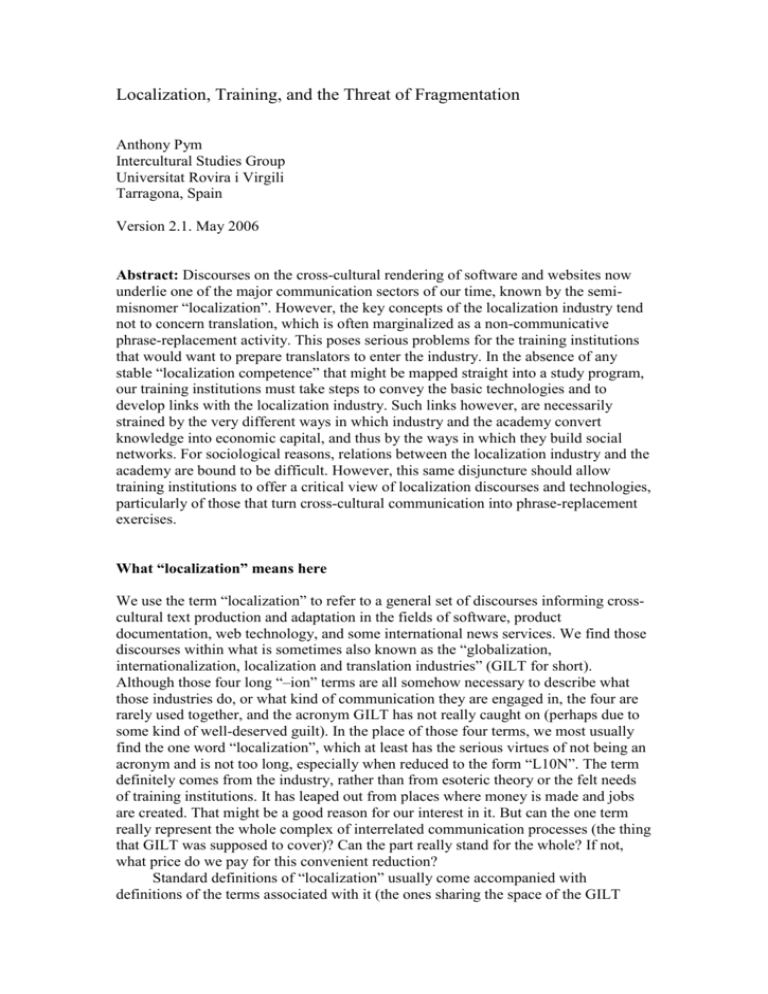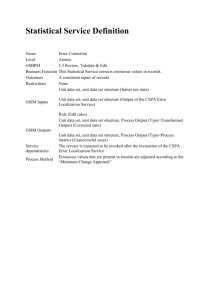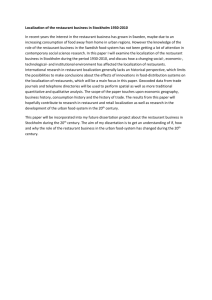Localization, training, and the threat of fragmentation
advertisement

Localization, Training, and the Threat of Fragmentation Anthony Pym Intercultural Studies Group Universitat Rovira i Virgili Tarragona, Spain Version 2.1. May 2006 Abstract: Discourses on the cross-cultural rendering of software and websites now underlie one of the major communication sectors of our time, known by the semimisnomer “localization”. However, the key concepts of the localization industry tend not to concern translation, which is often marginalized as a non-communicative phrase-replacement activity. This poses serious problems for the training institutions that would want to prepare translators to enter the industry. In the absence of any stable “localization competence” that might be mapped straight into a study program, our training institutions must take steps to convey the basic technologies and to develop links with the localization industry. Such links however, are necessarily strained by the very different ways in which industry and the academy convert knowledge into economic capital, and thus by the ways in which they build social networks. For sociological reasons, relations between the localization industry and the academy are bound to be difficult. However, this same disjuncture should allow training institutions to offer a critical view of localization discourses and technologies, particularly of those that turn cross-cultural communication into phrase-replacement exercises. What “localization” means here We use the term “localization” to refer to a general set of discourses informing crosscultural text production and adaptation in the fields of software, product documentation, web technology, and some international news services. We find those discourses within what is sometimes also known as the “globalization, internationalization, localization and translation industries” (GILT for short). Although those four long “–ion” terms are all somehow necessary to describe what those industries do, or what kind of communication they are engaged in, the four are rarely used together, and the acronym GILT has not really caught on (perhaps due to some kind of well-deserved guilt). In the place of those four terms, we most usually find the one word “localization”, which at least has the serious virtues of not being an acronym and is not too long, especially when reduced to the form “L10N”. The term definitely comes from the industry, rather than from esoteric theory or the felt needs of training institutions. It has leaped out from places where money is made and jobs are created. That might be a good reason for our interest in it. But can the one term really represent the whole complex of interrelated communication processes (the thing that GILT was supposed to cover)? Can the part really stand for the whole? If not, what price do we pay for this convenient reduction? Standard definitions of “localization” usually come accompanied with definitions of the terms associated with it (the ones sharing the space of the GILT industries). Here, for example, are those offered by the Education Initiative Taskforce of the Localization Industry Standards Association: Localization involves taking a product and making it linguistically and culturally appropriate to the target locale (country/region and language) where it will be used and sold. Internationalization is the process of generalizing a product so that it can handle multiple languages and cultural conventions without the need for redesign. Internationalization takes place at the level of program design and document development. Globalization addresses the business issues associated with taking a product global. In the globalization of high-tech products this involves integrating localization throughout a company, after proper internationalization and product design, as well as marketing, sales, and support in the world market. We might thus say that there is one general process called “globalization” (here understood at the level of the individual company), of which “internationalization” and “localization” are parts. In order to globalize, you first make your product general in some way general (“internationalization”), then you adapt (“localize”) to specific target markets (“locales”). The terms are by no means as standard as they may appear (Microsoft uses them very differently, especially for degrees of internationalization). Yet they encapsulate a whole logical process, a coherent view of the ways in which cross-cultural marketing can be carried out in an age of information technology and international capitalism. Together, those terms can form a whole. If the one word “localization” should simply represent that whole, it might thus be a matter of mere convention, and little more need be said. Yet things are not that simple. For example, we have described this whole as a “process of communication”, but exactly who is communicating with whom through a localized product? What are the effects of the massive amounts of technology that stand between any sender (perhaps now a “developer”) and any receiver (now a profiled “user”)? Or again, more worryingly, what is the precise role of “translation” within this wider whole? The term “translation” is indeed part of the GILT tetra; but it has no place alongside the reductions L10N or i18N (for “internationalization”). No one talks about “T09N”. Translation is definitely not cool enough for a neologism. We suggest that these simple questions, if pursued, reveal that the whole known as “localization” is far more fragmentary and problematic than it might first appear. Many of its visions are in fact of no more than parts. What localization is not If this coherent set of communication processes exists, then the term “localization” should not be reduced to a mode of translation constrained only by the norms of target-culture usage. That could be a correct reading of the phrase “make [the product] linguistically and culturally appropriate”, which we might otherwise term “adaptation” or perhaps “re-marketing” (on a par with Ezra Pound’s dictum “Make it new” in the field of poetry translation). The notion of adaptation is certainly present as a communicative ideal. One does frequently hear localization professionals state that the end user of the software, website or product documentation should be able to interact with the product in a “completely natural” way, as if the product had been developed from within the target locale. However, the economic workings of the industry are very far from such ideals. In the interests of efficiency, the communication process also involves significant internationalization, the production of a neutral, generic product, apparently culture-free (in fact belonging to the technical culture of the localization industry itself). Internationalization then allows for numerous modes of semi-automatic translation and multilingual content management. Those technologies in turn tend to incur constraints that are far more powerful than any ideals of pristine end-use locales, apparently unaware of where the products come from. And those constraints almost invariably ensure that the resulting language is anything but adapted or “linguistically and culturally appropriate”. The key to localization processes is internationalization, the initial production of the generic, and not adaptation. If you doubt it, just ask why we all put up with the phrase “1 files left to download”, in many languages. Second, as a consequence of this wider context, the use of the term “localization” to denote just one part of the whole is bound to be misleading. And yet that is precisely what is happening in some of our training institutions. A course in translation memories should be a course in translation memories, not in localization. A course on how to create and translate websites does not necessarily deal with localization. A course in “how to write for translation” (i.e. how to produce texts that are going to be translated into many languages) has a lot to do with internationalization, but is certainly not teaching the whole of localization. A course on comparative cultural behavior, using the paradigms of Hofstede and the like, might reflect some of the naïve ideals of theory but is certainly not to be confused with the realities of the localization industry. Further, courses in terminology management or content management convey very useful software-application skills but do not necessarily have anything to do with localization. And even courses in project management, of the kind much needed by the industry, ultimately involve basic business management skills; they need not have anything in particular to do with localization itself. All these things are part of localization processes; they all involve skills that are in demand in the industry; but none of them by itself can properly be labeled a course on localization. Some of our training institutions, at least in Europe, certainly do offer courses and programs in “localization” that involve one or several of these individual skills. They use a fashionable term in order to suggest that their teaching is somehow in tune with developments in the industry. More often than not, the institutions are repackaging traditional skills under deceptively new labels. In so doing, they offer no more than fragments of what should be seen as a wider, more complex and problematic whole. Hence a first threat of fragmentation: Our training institutions cannot see, or in some cases even name, the professional whole. Is there a localization competence? Of course, this use of the term “localization” within our institutions could be a simple fact of academic marketing, which has no need to be judged in terms of right or wrong (student enrollments and job placements are more significant guides). Further, the fragmentary nature of training courses is perhaps not entirely a misrepresentation; it may reflect something deeper within the localization processes themselves, and indeed within the localization industry. Let us probe this possibility with a question: We may freely admit that our training institutions can convey numerous skills that are in demand within the localization industry, but do those skills add up to anything like a unitary “localization competence”? It is easy enough to recognize a “translation competence”, and to break that down into aptitudes, skills and knowledge that a translator should have in order to be a competent translator. An institution can then use that model in order to set about training translators. The same could be said of the various kinds of interpreters, whose professions correspond to different kinds of interpreting competence. But how can we think in those terms with respect to localization? Who or what is a competent localizer? Impossible to say—localization is carried out by teams. When we ask this kind of question, we quickly discover that the localization industry is not configured in the same way as the traditional markets for translators and interpreters. Its training needs cannot be approached in the same way. If localization is a competence, it is certainly not one in that same way that translation and interpreting are. Divisions of labor Localization processes certainly do exist, at least as logical steps that a product has to go through in order to be localized successfully. Here, for example, is a basic process model for the localization of software: Analysis of Received Material Scheduling and Budgeting Glossary Translation or Terminology Setup Preparation of Localization Kit (materials for the translators) Translation of Software Translation of Help and Documentation Processing Updates Testing of Software Testing of Help and Publishing of Documentation Product QA and Delivery Post-mortem with Client. There is a certain competence involved in getting all these things to happen in a timely and coordinated way (or better, controlling the chaos when they all happen together). That competence is called “project management”, and it is useful for any kind of work that involves teams and projects. (Note, in passing, that localization work can also involve long-term maintenance or up-date programs as well as projects, for example in the case of multilingual websites.) Within this localization process, there is work for people competent in terminology, revising, testing, software engineering, and yes, translation. But all those things are usually done by different people. There is no one person there who acts as an all-round “localizer”. In its very nature, the localization project requires a significant division of labor. And it is in this structural and very necessary division that we might locate the underlying reason for the fragmentary visions of the process as a whole. Some might object that project managers do indeed see the whole, and that their competence should properly be described as “localization”. However, do project managers generally see what happens in the reception of the product, or in the rendition of all the languages? Managers often have to coordinate work into languages they do not know. Do they consistently see anything beyond times and quantities? Do they have time to do so? There are many variables involved, and the project management we most like in theory will certainly require all the visions we can muster, especially those involving translation. But one must seriously doubt whether project managers really require, in the eyes of the industry, competencies other than those associated with good business skills. One must then also doubt the industrial virtues of anything like a localization competence. What industry requires, and what various training institutions can supply, are sets of skills and aptitudes, some of which may involve translation. The role of translation This brings us to the role of translation. As can be seen in the above process model, translation is commonly seen as a part of the localization process. It is just one in a series of steps, and it is probably not the most important step (internationalization is the real revolution, and bad scheduling can cost more heads than a bad translation, as can a lack of testing). This state of affairs tends to upset translation theorists, whose maximum concession is to see localization as a special case of translation. The result is at best a dialogue of the deaf. From the perspective of training, we might partly resolve the dilemma by recognizing translation and localization as two aspects of cross-cultural communication. Within this frame, localization brings in specific key elements like internationalization and, as a consequence, considerable technological mediation and teamwork. Translation, for its part, concerns multiple features of interlingual processes that are overlooked in most models of localization. It, too, has its specificity. This way of approaching the two terms also has its geopolitical dimension. As is well known, most localization projects go from English into other languages. The labor requirements in English-speaking centers are thus likely to be quite different from those found in projects into more peripheral languages. We should therefore not be surprised to find the United States offering many programs in technical writing (including how to write texts that are to be translated), whereas Europe invests considerably more institutional effort in training translators as such. One might also venture the general impression (awaiting some kind of empirical verification) that many project managers in the US come from business backgrounds, whereas many project managers in Europe have been trained as translators or come from backgrounds that concern languages. The producing centers require the skills closest to internationalization. The actual localization processes require the services of translators. This is by no means a neat balancing act. The division of labor commonly involves reducing translation to a basic phrase-replacement process. There are several reasons for this. Translation memory programs break texts into phrase and sentence units, inviting translators not to alter the renditions already in the memory. The mind of the translator is consequently moved from the level of text and communication to that of phrase and formal equivalence. Alternatively, much translation work is outsourced to freelancers in the form of Excel files and the like, along with specific glossaries but rarely with indication of context. All the translator has to do is render the text at phrase level, respecting the glossary. Translators are often not trusted to do anything more spectacular. And rightly so: most of them have no specific training in the fields being localized, and they have only a vague awareness of what the entire localization process involves. If any special aptitude is required here, it might be capacity to put up with prolonged donkey-work. That is one scenario. It embodies the fundamental paradox of localization. The communicative frame that superficially promises complete adaptation to a new locale threatens to reduce its lingual component to precisely the opposite. Translation becomes the phrase-level replacement exercise it was thought to be in the 1960s and 1970s, in the days of the linguistic equivalence paradigm. Since then, some thirty years of translation theories have increasingly seen adaptation as a legitimate part of the translator’s activity. The process of localization would want to take that progress and place it in the hands of its marketing experts and desk-top publishers. Translators are turned back to the basics. There is an alternative scenario. Some localization companies (and some of their clients) increasingly appreciate that bad translations result in bad localization projects, with economic consequences at the point of the end-user. They are also aware that experienced translators have cultural skills that can help in the marketing of products in new locales. The established concept of translation as phrasereplacement is thus undergoing some revision. Yet we are unable to say to what extent this is happening, nor to what actual effect. The role of training institutions How might these competing scenarios be addressed within a training institution? Here are a few suggestions: First, students should be warned about the kind of donkey-work jobs being created in the localization industry. They should be advised to work their way, as soon as possible, into the more creative (and lucrative) positions available. Even better, they should receive the added business skills needed to have them start somewhere in the environs of project management. Second, some means should be found to open up more lines of communication with the industry, in such a way that the competencies of professional translators might become a source of shared benefits. This is happening as the odd localization professional is employed in a training institution, presumably indifferent to the salary drop. There is also a handful of academics seriously interested in discovering what is happening in the localization industry. But they are only a handful, unfortunately surrounded by crews of cultural theorists who are sure they know where everything is headed. Third, teamwork and project management should become parts of our training in technical translation and translation technologies. This should happen throughout the entirety of our programs, both within translation courses and in projects involving other faculties (law, engineering, informatics, etc.). Through the various modalities of inter-professional teamwork, our students should become aware of the range of services they can provide, avoiding any illusion that there is only one eternal kind of professional translator. In our own age, translators are called upon to do much more than translate: documentation, terminology, rewriting, and the gamut of activities associated with the localization industry. There is also a wide range of professionals who have to learn how to interact with experts in cross-cultural communication. Fourth, those training institutions that also incorporate research programs (usually at PhD level) should be seeking research contracts with the localization industry. This has been done by the Localisation Research Centre at Limerick in Ireland, and there are reports of cooperation between SAP and several German training institutions. However, as a general rule, research cooperation between industry and the academy has been very scant, sometimes reduced to the use of students for the testing of products. Industry vs. academics All those things can be done, and some are being done in small, tentative steps. The Education Initiative Taskforce of the Localization Industries Standards Association (LISA) currently has seven university members, which is quite respectable. However, that is just seven of the more than 300 translator-training institutions in the world. The process is gradual, and fraught with mistrust on many sides. Let us venture a few broad reasons why this should be so. Academics tend not to take the localization industry seriously because they, the academics, have established themselves in apparently stable professional fields (technical translation, literary translation, conference interpreting) and see no reason to change. The new kid on the block seems to offer no more than hype and money, without the humanistic discourses still treasured by ageing teachers (“translation helps create dialogue and peace among the peoples of the earth”, and so on). On the other hand, localization experts mistrust academics because they think that they, the academics, know nothing about the industry, or about any real-world industry for that matter. And they are often quite right. Yet there is perhaps more to this than a simple stereotype of opposed backgrounds. The localization industry has done much to create its own social field (in Bourdieu’s sense), and part of this creation is the production of its own modes of training. Localization professionals do not simply lament that the world’s translation schools fail to produce good employees; they are developing significant training programs themselves. Thus we find courses offered by a “Localization Institute” in the United States, and web pages called things like “Localization 101” (which has unfortunately disappeared, after we made fun of it a few years ago). In the web pages of the Localization Institute you can find online tutorials in basics like how to use WinAlign in Trados WorkBench. The student is asked to pay something like $200 for two PowerPoint tutorials, and then has the right to five hours of online “coaching”. The pedagogical discourse is fascinating. Not only does the industry seek to imitate academic training institutions (institutes, courses, etc.); it has adopted the money-forknowledge practices of the peripatetics (except that Socrates purportedly only asked for money after the lesson, if the student thought they had learned anything). All this happens while industry experts insist that the academic institutions being imitated are of little practical value. Localization seminars and conferences are remarkably instructive in this regard. The man in suspenders wants several hundred dollars from each participant in his seminars on internationalization; some company directors pay this, not because the expert necessarily knows more than them, but because he will be a kind of football coach, a motivation man, for the company’s employees. It is a good investment. As for the actual conferences, they can cost participants some $700 a day, and are spatially designed so that the full fee will get you to the inner circle of knowledge (people speaking and showing), whereas a reduced fee will allow you into the outer fringe of the “demonstration area”. The only free knowledge is website hype. Such is industry. Knowledge has market value if it is expensive (Bourdieu might talk about the immediate inter-convertibility of cultural and economic capital), at the same time as high fees keep the riff-raff out and enable organizers to offer reductions to the people they like (for Bourdieu, they restrict the circulation of social capital—the people you know and exchange favors with). The economic is converted swiftly into knowledge and networks. Academic seminars and conferences tend not to operate like that. In Europe, at least, we are quite good at converting cultural capital (knowledge) into symbolic capital (titles and degrees), without any quick conversion into economic capital (money). The localization industry can then only imitate the symbolic capital, and disdain the rest. Thanks to this fundamental difference, our social capital (the people we meet and know) tends not to include representatives of the localization industry, and their social capital certainly does not include us. Hence the two worlds, with occasional wormholes between. Training against the industry The threat of fragmentation is very real. In many parts of the world it is now much more than a threat; it is a new reality. There is no such thing as a “translation industry”, in the singular. The really strange thing is that many training institutions still fail to see this. And this in itself is the result of perhaps the most problematic fragmentation: the breaking of the weak but traditional relations between training institutions and the various segments of the translation industry. The result is the formation of several quite different social worlds, multiplying the distinctive logics mapped out above, with the localization segment operating in a way quite different not only from anything that academics are used to, but also from most tradition sectors of the translation and interpreting professions. Given this scenario, the role of our training institutions should probably not be to cater to or reflect the fragmentation. We should not suddenly be adjusting all our courses to fit the labor gaps that open momentarily in the industry. But then, nor should we be turning our back on what is happening as new technologies shape new professional sectors. This means two things. First, we must be teaching the basic technical competence that will save the localization industry from exploiting public ignorance (none of our students should be paying $200 for an introductory PowerPoint presentation of Trados—they should be quite good at finding all the technical information they want on the web and in discussion groups). We ignore technology at our peril; we must be there. Second, and far more important, we should be able to edge our students toward a vision d’ensemble, an overview of what cross-cultural communication is, of how it is being affected by technology, and of how far the current practices of the localization industry have moved from any kind of humanistic dialogue of cultures. Both those things should be done at the same time, if enough disaffected localizers and technocratic academics can be found. In a word, our students should be able to work not just within the localization industry, but also against it. With luck, they might one day be able to communicate, rather than just replace internationalized phrases.








